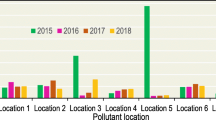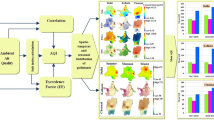Abstract
In this article, the authors apply the relative air pollution index (RAPI) proposed by Pham Ngoc Ho for aggregate assessment of daily air pollution level (RAPId) using data from 3 daily standards (1, 8, and 24 h) of each country’s standard, including Vietnam Technical Regulation QCVN 05:2013/MONRE. By using the automated data of ambient air at 3 monitoring stations in Cam Pha coal mining area, Quang Ninh province in 2018, results of the frequency of pollution by month (f%) have shown that overall, the air quality in dry season (October–March) is worse than that in rainy season (April–September). Results of pollution frequency by month in a year f% also indicate that air pollution in 2018 at 3 stations is mostly at level I (no pollution) with f% ranged from 10 to 58.3%, but pollution level II–IV (light pollution–very heavy pollution) also happened as f% fluctuated from 20 to 42% in some months. Comparing with air quality assessment in 2011–2015 at this area by periodic monitoring equipment of Quang Ninh Center for Environmental Monitoring, results in 2018 have shown that individual index of RAPI is consistent with the current status of air quality with high accuracy. To compare with RAPId, we used VN_AQId index of the Vietnam Environment Administration (VEA). Comparison results show that both indices do not encounter eclipsing effect. However, ambiguous effect occurred in the case of VN_AQId index (warning not suitable for reality in some cases). In addition, advantages and limitations of these two methods have been analyzed and explained in detail.







Similar content being viewed by others
References
Berliand, M. E. (1985). Forecast and atmospheric contamination. Leningrad: Hydrometeorological Publishing House.
Environmental Protection Agency (2006). Guideline for reporting daily air quality: Air quality index (AQI) (EPA–454/B–06–001). United States Environmental Protection Agency.
Environmental Protection Department (The Government of the Hong Kong Special Administrative Region). Air Quality Health Index. http://www.epd.gov.hk/epd/english/environmentinhk/air/air_quality/air_quality.html. Accessed 10 April 2014.
Hoang, X. C., & Hoang, T. T. (2010). Assess the development of air quality by pollution coefficient (API) through data of the automatic measurement station Lang, Hanoi 2004-2008. Journal of the National University Hanoi, Natural Sciences and Technology (in Vietnamese), 26, 678.
Kyrkilis, G., Chaloulakou, A., & Kassomenos, P. A. (2007). Development of an aggregate air quality index for an urban Mediterranean agglomeration: Relation to potential health effects. Environment International, 33(5), 670–676.
Ministry of Natural Resources and Environment (2013) National Technical Regulation on ambient air quality (QCVN 05:2013/MONRE) (in Vietnamese).
Nghiem, T. D., Dinh, T. H., & Nguyen, T. D. (2012). Study the application of air quality index (AQI) for management of air quality. Journal of Hydrometeorology (Vietnamese), 613, 13–16.
Ott, W.R. and Thom, G.C. (1976). Air pollution indices in United States and Canada – The present picture, presented at the 171stNational Meeting of the American Chemical Society, New York, NY, April 8.
Ott, W. R. (1978). Environmental indices - theory and practice. Annal Arbor Science, 147–169.
Pham Ngoc Ho. (2017). Relative air pollution index (RAPI) – A new method for aggregate air pollution assessment. Advances in Applied Science Research, 8(4), 62–69.
Quang Ninh Department of Natural Resources and Environment (2016) Automatic and fixed air monitoring stations (in Vietnamese).
Quang Ninh Center for Environmental Monitoring (2015) Report on the current air quality in Quang Ninh province in the period of 2011–2015 (in Vietnamese).
State Environmental Protection Administration (SEPA). Daily Air pollution Index of China. http://www.semc.gov.cn/. Accessed 2 April 2014.
Singapore National Environment Agency (2014). Pollutant Standards Index. http://www.nea.gov.sg/anti-pollution-radiation-protection/air-pollution-control/psi/psi. Accessed 27 March 2014.
Vietnam Pollution Control Department (2010) Build a set of indicators encompassing the area of air pollution (in Vietnamese).
Vietnam Environment Administration (VEA) (2011). Guidance for calculating AQI (quality index of air environment) (Decision No.878/QĐ-TCMT on 1st July 2011) (in Vietnamese).
Vietnam Environment Administration (VEA) (2019). Guidance for calculating AQI (quality index of air environment) (Decision No.1459/QĐ-TCMT on 12th November 2019) (in Vietnamese).
Wallace, L. A., & Ott, W. R. (1978). Rapid techniques for calculating the pollutant standards index (PSI) (EPA-600/4–78-002). Washington: U.S. Environmental Protection Agency.
Acknowledgments
The authors hereby express sincere thanks to Quang Ninh Department of Natural Resources and Environment for providing monitoring data for the article.
Author information
Authors and Affiliations
Contributions
1. Anh Viet Thi Pham: responsible for drafting and revising the article
2. Dung Manh Do: responsible for the acquisition of data, data series processing, and individual index calculating
3. Ha Thu Thi Pham: responsible for calculating temporary weight, final weight, and developing hierarchical rating scale of the aggregate index
4. Trang Thu Phan: responsible for calculating aggregate index, frequency of pollution, and graphing results
5. Ho Ngoc Pham: responsible for approval of final manuscript, corresponding author
Corresponding author
Additional information
Publisher’s note
Springer Nature remains neutral with regard to jurisdictional claims in published maps and institutional affiliations.
Rights and permissions
About this article
Cite this article
Pham, A.V.T., Do, D.M., Pham, H.T.T. et al. Application of relative air pollution index (RAPI)—a new method for aggregate assessment of current air pollution in Cam Pha coal mining area, Quang Ninh province, Vietnam. Environ Monit Assess 192, 411 (2020). https://doi.org/10.1007/s10661-020-8242-1
Received:
Accepted:
Published:
DOI: https://doi.org/10.1007/s10661-020-8242-1




